Discovering Raw Milk
Written by Megan of Stetted.
Milk has a place on almost every table across North America. From the days of door-to-door delivery in glass bottles to the wide rows of brightly-lit jugs in our supermarkets, milk is something we reach for at breakfast, lunch, and dinner.
These days, it’s a difficult task to keep track of which kind is best to give to your family. From cow milk to goat milk, coconut milk to almond milk, the market is saturated with choice. But there is one choice that is likely missing from your neighborhood grocery store: raw milk.
My family was hesitant at first about raw milk. We had tried some low-temperature pasteurized milk and didn’t like the flavor. The word “raw” conjured images of strange food and a culture many of us don’t understand. However, we were blown away when we tried our first glass of whole raw milk, and now we’ve been drinking it for a full year. Pasteurized milk now tastes strange to me.
What is Raw Milk?
Raw milk is produced on small farms and comes from cows that are free to roam on the pasture, eating a healthy diet of clover, barley, grasses, and whatever else pops up in the field. This diet helps the cow have a healthy gut, and in turn, helps create creamy milk that is full of flavor.
Whole raw milk looks strange at first, because the cream rises to the top. On a good gallon of milk, the three or four inches at the top are cream – about half a quart. It can easily be poured off and saved (or used to make your own butter), or you can just shake it into the milk whenever you pour a glass.
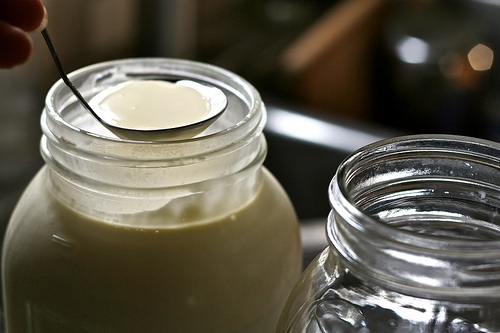
What Raw Really Means
Raw milk simply means that the milk isn’t heated, unlike the milk we’re used to from the grocery store. Raw milk is taken from the cow, filtered, and cooled rapidly to just above freezing. Standard milk is first heated to high temperatures very quickly, and then brought down to chill. While the high temperature pasteurization kills any potential pathogens, it also kills lots of the good kind of bacteria you do want in your gut.
Once opened, a container of raw milk can last about 10 days, provided it is properly chilled. We keep our milk the the back of the refrigerator and haven’t had a worry about the milk going bad. And when raw milk goes “bad”, it is still useable. It gets sour, but it can be used for making yogurt, cottage cheese, and even baking.
Pasteurized and UHT (ultra-high temperature) milks need longer shelf lives because they are shipped all over the country, but their freshness once opened is still the same as raw milk. In fact, I’ve had organic pasteurized milk go bad after being open only 4 days, even though the “Best by” date was not for two more weeks. Since you’re getting raw milk directly from the farmer, there’s none of the worry about how long the milk has been sitting in a warehouse cooler.
Benefits
Why drink raw milk? Aside from promoting a local, real food economy, there are a multitude of benefits in drinking raw milk, according to the Weston Price Foundation.
- Raw milk contains a lot of butterfat, which is needed by the body to be able to absorb the calcium and protein in the milk.
- Raw milk is said to do everything from help with allergies (due to the varied grasses the cows eat) to ear infections.
- Raw milk helps with bone growth and can recalcify teeth.
- Raw milk has beneficial bacteria that helps the digestive system and boosts nutrient absorption.
- Raw milk naturally contains 21 minerals and 13 vitamins.
Making the Next Move
As with any food, you need to make your own decision on whether raw milk is right for your family. Currently raw milk is not allowed to be sold in stores in most states, and you might have read about crackdowns on farms across the country. The truth is that yes, sometimes raw milk causes illness – but so do eggs, peanut butter, leafy greens, and beef (and those cause it in greater numbers).
With anything that you eat, information is key. If you are curious about raw milk, go visit a producer to ask questions and see the way the cows are treated and how the milk is collected. You can find raw milk producers by visiting RealMilk.com.
Have you ever tried raw milk? Would you let your family have it?

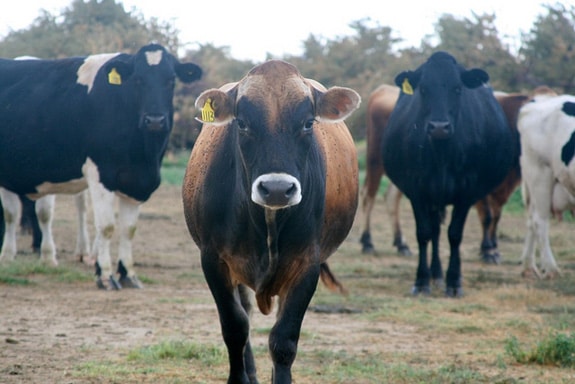
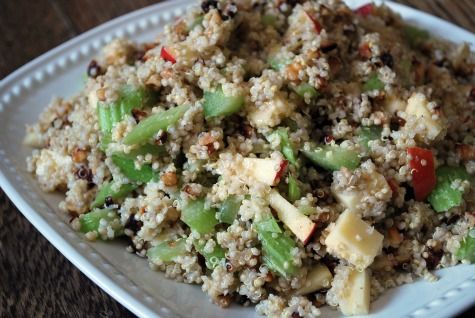
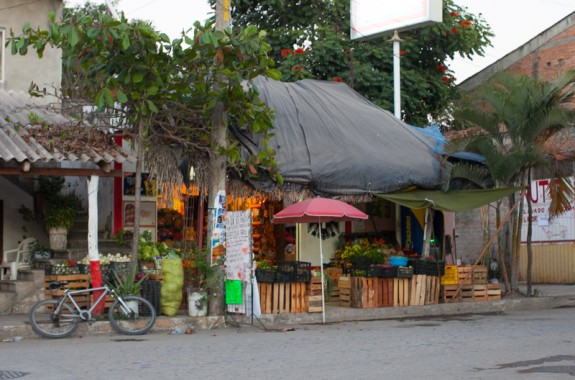

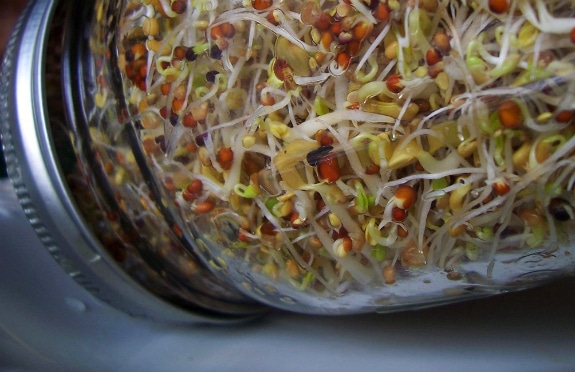
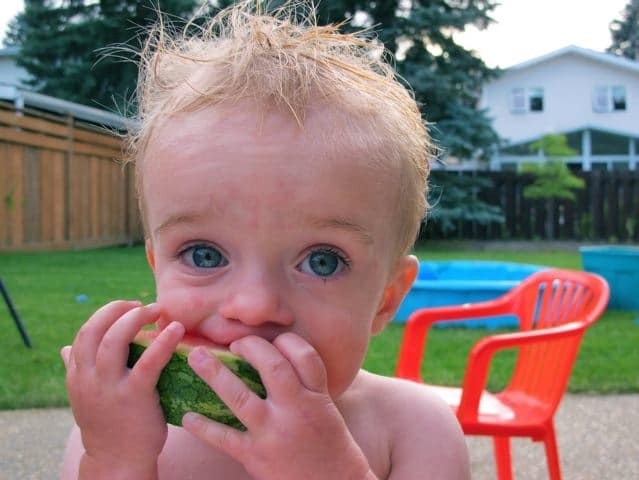

Like most Asians, we’re lactose intolerant. Or so we thought. We were able to try some whole raw milk at a farmer’s market in Campbell, California. The vendor told us that we’d be fine to drink raw milk because it already has the bacteria to break down the lactose.
He was right! We didn’t suffer any ill effects from drinking the raw milk.
Unfortunately, now we’re living in Malaysia where the only milk available is UHT. It’s terrible stuff. But if we wanted fresh pasteurized milk, it would cost a bomb. And forget about raw cow’s milk. I think the best we could do around here would be goat’s milk.
I would definitely use it if I could find it in the city. I clicked the link and noticed there’s a seller of raw sheep’s milk at Jean Talon Market, but I don’t know if I’m ready to switch animals! There’s such a comfort in familiarity. Raw milk is definitely on my list, though.
The list I posted is not all-inclusive, I’ve noticed, but it’s the best place to start. You might consider asking around at the market to get some connections!
I’m totally convinced about the benefits of raw milk and I’m not worried about getting sick from it. My question is about whether or not the benefits would carry over if I use it in other ways rather than drinking it straight. My toddler son, who drinks a couple cups a day, would of course benefit, but my husband and I don’t really drink milk straight. We only drink water and coffee. We put milk in our coffee, cook with milk, and sometimes make cheese, but I wonder if heating the milk in these uses destroys the benefits of the raw milk.
Maybe the answer is just for my husband and I to get in the habit of drinking some raw milk every day, eh? 🙂
Ivy,
There are many ways to make raw cheeses and raw yogurt that would retain the benefits w/o having to drink milk straight. Cooking with it would negate them, but putting it in your coffee, as long as the milk doesn’t get over 118F, won’t kill the good bacteria either. 🙂 Katie
Ivy Mae,
I didn’t used to drink milk straight, until we started getting raw milk. It tastes SO MUCH BETTER, and doesn’t give me problems with my lactose intolerance. My son drinks a lot more than he used to, and we (two adults and one 3-year-old) go through 2 gallons a week now (and that is with rationing the last couple of days. We get fresh butter or ice cream from the cream on top, too. And I haven’t had any weight gain from drinking more dairy products, in fact, as we’ve started eating cleaner, more whole foods, I’ve actually lost weight. Go figure 🙂
Anyway, if you wanted to get in the habit of drinking more milk, it might be the easiest habit to start!
This is really cool. I had no idea what raw milk was. Thanks for sharing!
We are HUGE raw milk fans. In fact I am making raw cheese today with a few extra gallons we picked up from the farmer. I, too, was lactose intolerant, or so I thought. I can easily handle cultured and raw dairy with no problems. And our boys have thrived on the stuff, even from infancy when I was unable to make enough milk for them.
I think everyone should know both sides of the story, and with all food, they should know where it comes from. People can just as easily become sick from grocery store spinach as they can raw milk from a farmer who isn’t taking the proper precautions for his animal or his milk. Sick is sick, which is why knowing your farmer is so important.
My family and I, including my almost two year old son have been drinking raw milk for about 7 months now. It not only tastes great but I know it’s the healthiest choice I can make for my family. I feel lucky that I can find raw milk at local farm stores or directly from the supplier in my area. It’s definitely more expensive, between $5-$6 a gallon but I can also see the farm on which the milk it coming from and it’s not a factory and the animals are treated well. I’m not rich, I have a food budget too but in this case health out ways the price.
Below is an article about my local raw milk supplier…
Milky Way Farms located in Starr, S.C. Milky Way cows are all Jerseys. These cows are known for their high overall quality of milk. The milk has 20% more protein, 20% more calcium and 25% more butterfat than most other milks. And Milky Way cows graze in a relaxed pasture and receive no hormones or steroids. In addition, the S.C. Health Department tests Milky Way milk monthly for e.coli, bacteria, and SCC (somatic cell count which can indicate mastitis infection), and yearly for TB and Brucellosis (Bangs disease). Milky Way Farms also voluntarily tests its milk annually for Johnes disease to ensure the healthiest cows and best quality milk available.
Be sure your local raw milk farm is tested in these areas. So your not paying top dollar for your milk buy it straight from the supplier, it costs me about $1 less a gallon. You can find the article I quoted above at: http://www.beluefarms.com/index.php?option=com_content&view=article&id=62
I had the honor once of drinking the milk from a cow in Ireland right after she was milked. It was the first time she had ever been milked. I was in heaven. Just so you know, we still get our milk delivered in glass bottles from a local dairy. I checked the link though, they don’t have raw milk.
I’d love to be able to drink raw milk but in Canada unless you have a farmer friend just giving you the milk it’s nearly impossible to get as it’s illegal for farmers to sell their milk to individuals. One day, when we finally get our dream land, the first thing I’m getting is Chickens, quickly followed by a dairy cow!
I’m a total raw milk convert. It’s delicious, offers much more nutrition than pasteurized milk, and the raw milk farmers have a much higher standard of health and cleanliness for their cows than pasteurized milk dairy farmers, so I don’t worry about possible contamination.
When raw milk sours, that’s when it’s gold. I leave a sour jug out on the counter for 3 days, pour it through cheesecloth and I have savory cream cheese and whey. The whey is invaluable for lacto-fermenting, so don’t throw it away!
Great tip, Lynn!
Wow, great tips, Lynn! Savory cream cheese – mmmm.
Clabber, I love it and so do my chickens, lol! We’ve bee drinking raw for 3 years now and wouldn’t go back… ever! Now that the Spring is here, we’re going to have such rich nourishing milk and cream 😀
This made me chuckle, Diana. My chickens love this, too! They love milk, sour milk, yogurt, whey & cottage cheese from our local raw milk provider. They wade right into it and come up with wattles covered in white. It’s so funny! Then they spend the next hour preening and cleaning. The farmer has told us that he feeds colostrum from his cows to his chickens every spring because he feels it to be a wonderful tonic for them after a long winter without many bugs. We also make cream cheese (I always put chives and thyme from the garden in mine) with ours. Great post, Megan!
I have never tried it. I would like to, and if, I didn’t get sick from it, then in the future, I’d probably let my future children have it. Informative article; I hope I can try it soon!
So interesting!!
Oh hi, Megan! Thanks so much for this post…I’ve been curious about raw milk. I’m going to look for it at the Farmer’s Market now. 🙂
My husband grew up on raw milk from his uncle’s farm (a few hours from us). None of his nine family members have ever been sick from the milk.
Because of where we live, our access to raw milk is limited, especially in the winter months. This forces our choice to be organic, grass-fed non-homogenized milk during that time period.
You should definitely check out the farms that are offering raw milk, some even offer tours. But don’t assume that the cows are all consuming clover, grass, etc. Some, including a farm near us, feeds their cows a great deal of corn and is looking into feeding them soy as well. There is discussion about the difficulties of cows digesting corn and soy and the what is in the raw milk output from those cows (ex. if it’s as ‘healthy’ as grass-fed cows).
Oh how I struggle with this one! I was raised on raw goats milk from my grandmothers farm and was never ever sick from it. However, I became and adult, read lots of parenting books while pregnant and was made to feel that serving raw milk to my family was basically the same as pouring bacteria soup. Now I’m having to “de-program” myself, but it’s hard!
I’d like to switch back to raw milk, however I do think I would still drink pasteurized local milk when pregnant, just to be extra cautious. Now what to feed to our son when he weans….oh boy. Can’t I just breast feed forever? Oh wait…that’s another controversy!
Sarah,
We’ve done raw milk for about two years now, and I’m in the midst of my first pregnancy with raw milk. I never ever gave it a second thought, to be honest. I know there’s a risk to my unborn child IF there’s listeria in the milk, but I can’t be afraid of everything…I save fear for things like trans fats and stuff! 😉
I don’t think I’ll think a minute about giving baby raw milk when he weans, either. It’s just become part of our family. We’re on vacation right now, and I was struck by how WHITE the store milk is – ours is a lovely yellow because of the cream! It takes some time to get used to the idea of “good bacteria,” but really, it’s just like yogurt. Making your own yogurt is really making “bacteria soup,” but it’s the best thing for ya! 😉 Katie
I’ve been reading all about raw milk and had another question for you, pertaining to the more “cosmetic” concerns I have. I don’t mind the cream line at the top but I have also read that there is a kind of sludge that forms at the bottom from dead white blood cells and bacteria. From a purely visual point of view I don’t think I could handle looking at the sludge knowing it was dead blood cells! Anyone have any experience with this?
Megan,
After two years of raw milk, I’ve never ever seen that! Yuck! I’d recommend finding a farmer who will give you a sample – best way to see what it’s like! 😉 Katie
Megan – the sludge of white blood cells you are hearing about is from the pasteurization. The reason milk gets homogenized is to blend the cream and all the sludge together so you never see it. So if you get raw milk, you’ll only see the cream line, not the dead white blood cells 🙂
(I may be mixing up my pasteurization and homogenization terms, but you get the idea!)
I am really disappointed in this post. It is an advocacy for raw milk, but doesn’t discuss any of the risks or the science behind why raw milk would be a better idea than pasteurized (not ultra pasteurized). To make a decision to pursue raw milk based even remotely on this post would be wildly misinformed. While there are other food borne illnesses, before pasteurization, milk was the leading cause of food related illness and death. There are other things that went into this, but there are real risks associated with raw milk. Family friends of ours started their own raw milk dairy years ago, and then their daughter contracted E Coli from their own milk and nearly died from the complications. I would hope that any post advocating raw milk would at a minimum, discuss the risks in addition to the benefits. I’ve come to expect a more balanced view from this blog and hope that you would consider amending this post to reasonably discuss the risks in addition to the benefits.
I am really curious about the science of why raw milk should be better than pasteurized. I’ve never heard a good explanation. Also, milk, before pasteurization was the leading cause of food borne illness, why is it worth the risk? You didn’t cover any o
Hi Chris, thanks for your comment. There is already quite a bit of information against raw milk, from the U.S. FDA’s most recent campaign and of course media coverage from the crackdowns I mentioned above. I wanted to present the other side of the story. There are real risks associated with all food we eat, which is why I advocate for people to visit the places their food comes from, including raw milk dairies. My hope is that people would use this post as a jumping-off point for doing more research on their own.
Chris, thanks for expressing your concern – and for being a faithful reader. Both you and Megan make valid points. You know what? I grew up drinking raw milk -both goat and cow- and my three siblings and I reaped the benefits our whole childhood. I respect that decision of my parents.
I think it is up to each family do decide whether the benefits out way the risks ( I believe they do). And like Megan said, there IS a lot of press out there already that slams raw milk.
Again, than you for commenting, and I hope that we can still be friends. 🙂
They don’t need to present the risks of raw milk anymore than you have to present the risks of pasteurized. A brief search for “pasteurized milk” on the CDC website revealed a report of 3 deaths in 2007 from PASTEURIZED milk! Interestingly a search for “raw milk” produces all sort of warnings, but in my quick search I saw no reports of death.
I’m presently not a raw milk drinker and don’t necessarily advocate it, but I do advocate freedom. People are fully capable of researching the issue, weighing the risks vs. benefits and reaching a decision for themselves.
I tend to agree, Chris. While I understand wanting to present the opposite side of the story we all see, there are clear reasons for the recommendations presented by the FDA. I think it’s important in a post like this to express that, for individuals who may be immunocompromised, or for young children/older individuals/pregnant women, raw milk is an absolute health risk. Between 2000 and 2005, there were 44 infections reported to the FDA that were traced back to pasteurized milk. In that same time, there were 473 cases of infection related to unpasteurized milk (these were traced back specifically to the samples themselves, where bacteria were cultured to verify causality). In response to the point onemama raised, this caused 7 fatalities. Considering the relative popularity of the two ‘types’ of milk, these are striking numbers.
To address some of the earlier posts focusing on Listeria, this is not the only bacteria that you need to worry about. Salmonella has been the most common cause of infection, followed by Campylobacter (GI symptoms), and Mycobacterium bovis, a cause of systemic tuberculosis–in NY and MD, they had 40 cases of infection by M. bovis during the aforementioned period of time. These pathogens can cause significant harm in anyone, but again, PLEASE consider the risks if you plan to feed infants, children, older adults, and anyone with a suppressed immune system. In many ways, this is akin to serving a dish with raw egg–most of the time it will be fine, but you wouldn’t want to risk it with someone whose body isn’t up for a challenge if it’s presented.
Thanks to everyone for sharing their perspectives!
I was raised on raw milk, having the good fortune to grow up in a small Saskatchewan town 5 minutes away from a local diary producer. We’d get a five-gallon pail of it for $6 (a huge savings), and our family of six would burn through it in about 5 days. My mom used to call us boys her calves.
Now living in a big Canadian city with five kids of my own, I wish I could find a local source of raw milk to save us money AND improve our health.
We’re huge fans of raw milk. We’ve been drinking it now for a year and a half and are never going back, if we can help it. That stuff is liquid gold.
I would love to start buying raw milk, but when it’s $16 a gallon around here, I can’t afford it! I would love to find a less expensive source! I had the same question as a poster above, about using it for cooking. I have to admit, it’s hard for me to imagine giving it to chickens. As expensive as it is around here, that would be like giving them filet mignon! 🙂
Wonderful post. I am linking it to my FB page- wish it were easier to buy this type of milk. Unfortunately, it is almost like a black market – with prices out of site. I guess you need to be best buddies with a local farmer and convince them to let you buy some. Many farmers are afraid of law suits if anything happens to someone they sold milk to or if authorities catch wind that they are selling it to people “under the table”. It’s a sad situation- all in the name of protecting the people.
http://homestyleworldcook.blogspot.com
I grew up on Raw Milk. My neighbor used to deliver our milk to us in huge glass jars. Mr. Kelly was his name. What a great memory (and a great post!)
Wow, I never knew you could even buy raw milk. Amazing! I wish I knew if there were local farmers around here that sold it because I’d love to try it!
We are lucky that we can buy raw milk – and sometimes raw milk products – at our local markets. It’s really expensive though so it’s a good thing we’re not huge milk drinkers! My goal is to try making some butter and also raw milk yogurt. I tried the yogurt once and I definitely need practice or a better recipe or something. I was interested to read in your post about raw milk being able to recalcify teeth. Do you have a source for that one? I have one tooth that is losing minerals and my dentist has no idea why. Consuming more raw milk products would be an easy fix if it were the case.
I love Raw Milk. I was turned on to it about a year or so ago by a friend. My kids like it way better then the store bought milk and it is cheaper. i am pregnant and had so many questions with people telling me I should not be drinking the raw milk. After talking to my farmer i feel safe drinking it and feel it will be healthier for the baby I am carrying, My farmer made a point when he said you can get more bad bacteria from eating lettace from the store then deinking the raw milk from his cows.
Lena
Hello all,
I rarely wade into these kinds of discussions but felt compelled to on this one.
This whole debate over “raw versus pasteurized milk” really surprises me. Pasteurization is one of the biggest successes in public health and has saved hundreds of thousands of lives since it was put into practice so I guess I really don’t understand why it is still being debated.
As I see it, there are two reasons people want to consume it – taste and perceived nutritional benefit. As to taste, that isn’t something that can be quantified or even debated – you either like it or you don’t – so what really needs to be discussed is the nutritional benefits and risks.
Based upon the data, raw milk and pasteurized milk provide virtually the same nutritional value. The fat, protein and carbohydrate content for both raw and pasteurized whole milk are the same. The loss of vitamins and minerals (primarily thiamin, B12 and biotin) due to pasteurization is negligible. and raw milk does not contain significantly higher levels of any of these nutrients. As to the beneficial “flora” that is lost through pasteurization, the research is, at best, inconclusive regarding additional health benefits from probiotics . Regardless, there are a number of diary products (such as Activia, etc.) that have had the beneficial flora reintroduced after pasteurization and these products represent a far less risky means of obtaining beneficial bacteria. As to the benefits of raw milk in treating diseases, there are no studies which confirm that it is beneficial in treating any disease or condition and claims that it does are not backed by reliable science!
There is no question that raw milk carries with it a much greater risk of food borne illness when compared to pasteurized milk. Whether the cows are grass fed, conventionally fed, organic, raised on a small farm or a large one makes no difference – the only way to completely remove the risk is to pasteurize the milk.
So, having said ALL that I think raw milk should be legal even though there is no reason to drink it aside from taste. As to Megan’s question – would I serve this to my family? When my children were young, no I would not have – the risks compared to the benefits are simply too great as they are for anyone with an immature or compromised immune system. Now, will every child who consumes raw milk become ill? No – but is there a risk? Absolutely.
Bottom line I don’t think anyone with a compromised or immature immune system should drink it since the risks far outweigh any benefit.
I agree with pretty much everything you just said. If people want to drink it I think that is their right and that they should be allowed to but to downplay the risks seems a little irresponsible. Sure, your family member or friend may have never had any problems but that doesn’t mean all raw milk is safe for everyone.
I know you can get sick from other items in the grocery store but if someone told you there was a type of eggs or peanut butter you could get that would greatly reduce your risk without sacrificing much of the nutrition wouldn’t you buy that one instead? I know we can’t be afraid of everything but I think we should attempt to minimize our risks.
I think the issue over pasteurization is mostly moot when it comes to locally sourced milk.
Pasteurization is definitely a scientific advancement not to be underestimated or rejected…but it came about at a time when our food was being industrialized and needing to be shipped long distances and stored until purchased by the consumer.
I’ve never had it, but have been intrigued. It may be something for me to try out soon! 🙂
I’ve never had raw milk, but I can only imagine how rich and flavorful it is!
Yes! We are raw milk converts. I wouldn’t give my kids anything else now. We get two gallons a week and make one into yogurt. Yum!
Very informative. This makes me want to stop being a scardey cat and serve the family raw milk. Which is funny since I drank it at my grandmothers. The irony of life 🙂
I’ve been drinking raw milk for almost twenty years, both cow and goat milk. The issue of harmful bacteria is really only a problem when a) the cows are not healthy, which being fed corn and soy can cause or b) there are unclean conditions present. Most farmers selling raw milk will not operate under these conditions, but if anyone is concerned farmers will often welcome a visit. We are blessed with too different sources of raw milk, both being small family farms that we have visited.
I always feel rude swooping in as the microbiologist, and would love to nod that healthy cows are risk free, but that is not the case! Listeria can actually colonize cows udders, and be part of a healthy cow’s natural bacterial flora, and as we know it is not so healthy for humans, especially pregnant women. So there is no way of telling what bacteria content there is by just looking at a cow and gauging how clean it looks. There may be less risk if there is a smaller cow:area ratio, because there would be less chances for the cow to pick up other bacteria, but it could also have been colonized by the bacteria at or around birth, so it’s really impossible to tell!
So yes, even if you visit the farm and see that the animal is health, you are taking a risk. A wonderful little farm by my house unfortunately had a listeria contamination in their milk, and were sued when a 7 month pregnant woman miscarried, which is very sad.
I do think it should be a choice whether or not you have raw milk, just like you can choose to cook your meat rare or well done, but it should also be clear to the consumers the risks that come with it.
I enjoyed reading the post and everyone’s comments. I would love to see more research on the topic. We don’t drink a ton of milk around here, but I do make my own yogurt and I bet it would taste so rich with raw milk. My husband is also very picky about the taste of milk, so I wonder if he would prefer it…someday we’ll find out!
i’ve been wanting to try it but am afraid. maybe this article is the final thing to make me try it!
I appreciate the comments here about the health risks, as it’s so hard to find *both* sides of anything anywhere on the web these days. We consume as little dairy as possible here and rely more on coconut milk and almond milk (and extended breastfeeding). Raw milk isn’t available here locally even though we’re in “the farmland” and here in MN some people did get pretty sick consuming raw milk from a very nice small dairy not too long ago.
I absolutely agree that it should be legal, though. I’ve really had enough of the government taking on a babysitting role and deciding what we’re allowed to do regarding our own nutritional, medical and safety decisions. If people want to buy raw milk, I think it’s ludicrous that they can’t. While I don’t want it for my family, I think those who believe in the benefits have a right to make their own decisions.
$16 a gallon though? Yikes! That strikes me as highway robbery. 🙂
We decided to try raw milk about a year and a half ago when we found out that people that have lactose intolerance can often drink raw milk with no trouble. My daughter couldn’t drink even a tiny amount of pasteurized milk without it making her really sick, but now?? She drinks raw milk everyday without any trouble at all. She loves it, and I love knowing she’s finally getting enough calcium every day! Raw milk tastes so much better anyway!
I would love to switch but haven’t been able to find it locally. We buy local organic for now. I’ve never been a big milk fan but my husband and boys think they can’t live without it. My husband grew up on a small dairy farm and drank the stuff by the ice cream bucket full. Their family never got sick from it. In fact, he’s been sick 2x in the 13 years I’ve known him. (He works in an office setting mind you!) I seem to catch something once a year even though I’m a SAHM and a health nut. We both were blessed to grow up on made from scratch meals with healthy snacks. He grew up with raw milk and well water. I grew up on Kemps and city water. Hmm, there MUST be something to that “liquid gold!” He has the immune system of Superman!
We go to Sam’s Club once a week and buy 6-7 gallons of milk. If I could find a farmer who lived near me selling raw milk, I would be all over it like white on rice.
NOTE to those who are afraid of the illnesses: You are more likely to get sick from the grocery store cart handle than anywhere else on planet EARTH.
My toddler got salmonella last year – bacterial nightmare and 3 day hospitalization – from eating out at a restaurant.
The benefits FAR outweigh the risks.
I have been drinking organic, raw milk for over two years now, and I have no hesitation feeding it to my kids. We are fortunate in Nor. CA to have access to a reputable producer (Organic Pastures), that sells via farmer’s markets and our local coop. I am extremely lactose intolerant, and as a result, I completely avoided dairy for over 20 years. Pasteurized cow’s milk products, even cheeses, make me extremely sick… as in doubled-over-in-pain cramps, blinding headaches, and all manner of unpleasant tummy troubles. But with raw milk? Not one problem, ever. And my three kids are the picture of good health. I can’t remember the last time one of them had a cold in the last couple years. Amazing.
That said, I would not touch raw milk from a “traditional” mass-production dairy farm with a 10 foot pole. There’s a reason they need to pasteurize that milk — the conditions are pretty disgusting from what I’ve seen. Stick to a local, organic, reputable source.
I haven’t had raw milk since visiting family when I was a kid. Great info!!
You had me at “cream on top.” I love high butterfat dairy products. Yes, I would definitely try it. I’m guessing this is the way people drank milk before more modern methods. And they survived 🙂
Thanks for the great overview! I’d love to try raw milk one of these days. It’s so pricey around here and we have no local farms to get it fresh from, but the health benefits sound so wonderful. For now I stick to cream top organic milk. I figure at least it’s non-homogenized and not UHT, like much of the organic milk in the stores.
Such an informative post. Organic milk is abit pricier, but the health benefits are so worth it-it’s actually all I buy for my little guy.
We used to call the raw milk from the neighbor “shake-up milk,” since we had to shake it to mix the cream before drinking. We loved drinking it, even if it was only for a while.
Thanks for the great article! In our state, they are not letting dairies sell raw milk (but from what I understand, that is changing). Right now, I can only get a low pasteurized milk from a local farmers market- and that comes from out of state! I love using it to make my own yogurt and feeding it to my growing boys! But whew, it’s expensive and a glass jar deposit on top of that too!
The reason pasturization of milk began was that dairy cows were being kept in extremely unsanitary conditions in cities, where they were frequently living in their own wastes. The conditions for unhealthy bacteria proliferation and contamination of the milk were perfect. Under those circumstances, pasturization saved untold lives. It probably still does where the conditions are less than perfectly sanitary. However, E coli infects the milk after it comes from the cow and is a result of inadequate hygene practices and can infect any number of food items while they are being processed. I think anyone considering using raw milk should minimally see firsthand the conditions under which the milk is handled, and that veterinary certification that all the animals are healthy (no tuberculosis, etc) might be something that should be a requirement. Also remember that you could contaminate the milk yourself by not caring for it properly, just the same as you could contaminate produce by handling raw chicken and not cleaning properly between.
I think it is really unfortunate that in Canada, it is illegal to sell raw milk, and I would certainly use it if I had the opportunity. I had severe allergic reactions to pasturized milk as a child, to the point that I grew up not drinking milk and don’t particularly enjoy it now, but no reaction at all to the raw milk my husband obtained when he worked on a dairy farm. I think it is interesting to note that a calf will not survive on pasturized milk.
And how many illnesses and deaths have been attributed to other even minimally processed foods in recent years? We currently have a recall of walnuts because people have become ill after consuming them from a certain processor. No one is suggesting that walnuts be “sterilized”, although I have heard that heating them in the oven as instructed in “Nourishing Traditions” has been recommended by at least one health expert on TV. Great topic, there’s bound to be a lot of controversy for some time to come.
Drinking raw milk is among the best thing we can give to our human body. You don’t only get clean milk but a very rich source of enzymes, minerals, vitamins, fats and friendly bacterias to aid in the digestive process. Remarkable discovery Megan. Keep up!
I live in a state where selling raw milk is illegal. I am blessed silly by a friend with cows. She brings me 4-6 gallons of fresh raw milk each week. I don’t know that my family could go back to our Costco milk… I dread the day she no longer has milk for us!
I have to weigh in with Nancy here, though I hate to be a Debbie Downer. My husband is a large animal vet and a major player in state and national animal health issues. After this issue came up with friend recently, I quizzed the other vets he works with and every one said that no way would they give their kids raw milk, and they would not have a pregnant woman drink it. If it’s the taste you’re craving, non-homogenized milk is (supposedly?) similar to raw milk. I think of it like raw eggs– plenty of people manage to eat raw eggs and not get sick, but would you give them to your toddler? Eat several raw eggs a day? I fear we’re going to be hearing of more problems (after accounting for the very low number of raw milk drinkers vs pasteurized milk drinkers, the health problems are heavily skewed toward raw milk drinkers) if more and more people head towards raw milk without looking at the data presented on both the human health and animal health sides. The average person simply does not hear about problems on the cleanest of farms, and how even feral pigs can transmit diseases that get into the milk. That being said, I’ve heard the milk tastes amazing, and I may have to try some (pasteurized!) non-homogenized milk to see what that’s like!